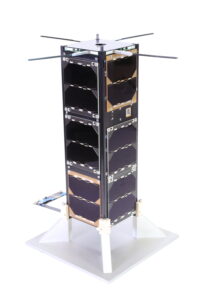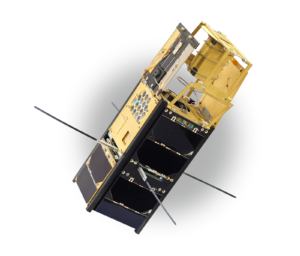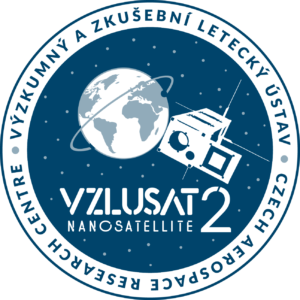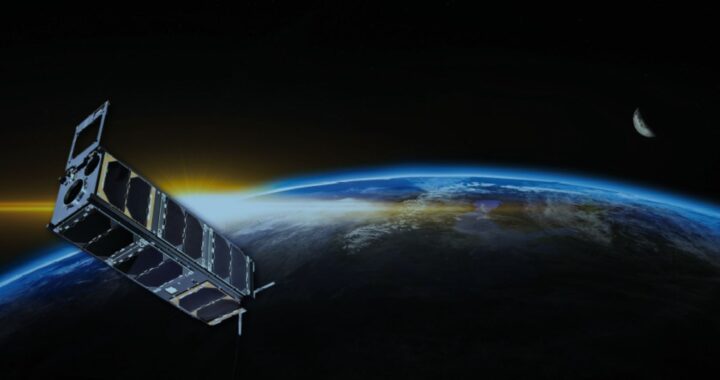These days, the VZLUSAT-2 satellite is celebrating a year in orbit, where it was launched by Elon Musk’s Space X Falcon 9 rocket on January 13, 2022. During that time, it circled the planet roughly 5,800 times. Since the beginning of its mission, VZLUSAT-2 has taken color and black-and-white images from several continents. It is fully under control and can (among other things) photograph any part of the Earth. It is the only satellite built in the Czech Republic capable of taking high-resolution photos of Earth.
Thanks to the involvement of the Czech Aerospace Research Centre (VZLU) in the global network of SatNOGS ground stations, it is possible to continuously monitor the telemetry data of the satellite on a publicly available website. Data is collected from more than 50 stations located around the world.

VZLUSAT-2
VZLUSAT-2 has dimensions of 10 x 10 x 34 cm and weighs 4 kg. It thus belongs to the category of nanosatellites, i.e., those that weigh a maximum of 10 kilograms. The lifespan is planned for two years; however, the team of experts who developed it believes it will be longer. It is the second satellite the Czech Aerospace Research Centre has sent into space. The first was VZLUSAT-1, which has been in orbit for five and a half years. The development of both satellites opens the door to further progress. „The Research and Test Aviation Institute currently has two satellites in orbit and handles the technologies needed to position them. But we have other plans. We want to create a constellation of four satellites, and thus we are heading toward an elite group of countries in this field. At the same time, we are counting on the fact that even the constellation of four satellites will not be „final“ for us and that we will continue,“ explains VZLÚ CEO Josef Kašpar.
The VZLUSAT-2 satellite is an essential part of the long-term SPACE2030 strategy. It confirmed the Czech Republic’s ability to create a satellite capable of recording an image from anywhere worldwide, which is possible thanks to precise orientation control. VZLUSAT-2 is the first Czech satellite equipped with this system. „In the mission, we also dedicated them to the optical system and data processing; thanks to the cooperation with the companies Eltvor and World From Space, today we can boast that we have fully verified technologies that are ready for other satellites that will be able to deliver much better images of the Earth. We are delighted that after a year in orbit, we can say that the project has already fulfilled almost all the set goals. It is definitely important for us that we were able to cover the cooperation between many entities from the Czech Republic. Thanks to our partners, which are Spacemanic, esc Aerospace, TTS, s.r.o., Rigaku Innovative Technologies Europe s.r.o., ADVACAM s.r.o., Eltvor, Needronix, Konkoly Observatory, and the universities of the Czech Technical University in Prague, West Bohemian University in Pilsen and Masaryk University in Brno. The project was supported by the Technology Agency of the Czech Republic and the Ministry of Industry and Trade,“ adds Juraj Dudáš, director of the VZLU’s Space division.

VZLUSAT-1
The predecessor of VZLUSAT-2 is the VZLUSAT-1 satellite, which has been in orbit for more than five and a half years. It was „launched“ into space on June 23, 2017, from India. Its lifespan was originally planned for one year. However, the satellite’s systems are still fully operational and provide scientific data. It is currently the longest-operating satellite that was built in the Czech Republic. „I’m glad that VZLUSAT-1, designed as a technology platform to try different things, is still working and communicating with us. It is not quite usual. In this category, satellites last a little over a year. Five and a half years for this type of satellite is a great success,“ says VZLÚ’s general director Josef Kašpar. „It’s amazing. Developing a satellite independently was a challenge. We sacrificed a lot of time for this at VZLÚ and together with partner companies and universities. The fact that VZLUSAT-1 still works today is probably the result of work and long testing of the entire system. And certainly a bit of luck as well,“ concludes Vladimír Dániel.
contact: pr@nullvzlu.cz


